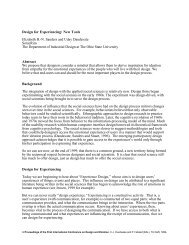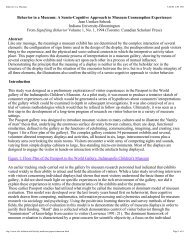: Interface as Content The Construction of Experience - ec(h)o
: Interface as Content The Construction of Experience - ec(h)o
: Interface as Content The Construction of Experience - ec(h)o
Create successful ePaper yourself
Turn your PDF publications into a flip-book with our unique Google optimized e-Paper software.
David Rokeby : Transforming Mirrors3/11/03 4:21 PMI’ve argued that virtual experiences don’t do justice to the richness <strong>of</strong> the human experience. I’mnot suggesting that the richness <strong>of</strong> experience cannot be incre<strong>as</strong>ed through interactivet<strong>ec</strong>hnologies or that the best interface would be one that exactly replicated the full experience <strong>of</strong>reality. In fact, designers <strong>of</strong> virtual experiences are <strong>of</strong>ten so literal in their attempts to simulate realitythat they stifle some <strong>of</strong> the most exciting potentials that these new media <strong>of</strong>fer.<strong>The</strong>re is an artist named Tam<strong>as</strong> Waliczky who h<strong>as</strong> been working with the idea <strong>of</strong> alternatesystems <strong>of</strong> 3-D representation. <strong>The</strong> conventional binocular, persp<strong>ec</strong>tival model that is currentlybeing standardized in s<strong>of</strong>tware and hardware is useful for normal representations <strong>of</strong> 3-D obj<strong>ec</strong>tsand space. <strong>The</strong> fact that it h<strong>as</strong> reached the level <strong>of</strong> silicon represents the kind <strong>of</strong> crystallization Imentioned above. Waliczky sees much broader possibilities for the representation <strong>of</strong> space thanthis limited Renaissance model. He h<strong>as</strong> been creating alternate persp<strong>ec</strong>tival systems, writing codeto render other experiences <strong>of</strong> space. In one <strong>of</strong> his works, he renders a world from the self-centredpoint-<strong>of</strong>-view <strong>of</strong> a young child. For another, he h<strong>as</strong> created a program that renders invertedpersp<strong>ec</strong>tive, in which things get larger <strong>as</strong> they get further away from you, and vice versa. This is areal mind-bender to see, a rich exploration <strong>of</strong> the potentials <strong>of</strong> virtual media to go beyond therestrictions <strong>of</strong> reality, and indeed <strong>of</strong> our own imaginations.I’m suggesting that there is a sort <strong>of</strong> middle-<strong>of</strong>-the-road virtuality, that does justice to neither ourrich experience <strong>of</strong> reality, nor the richness <strong>of</strong> possible virtual experience. This ‘MOR’ virtualitydiminishes experience in several dimensions without enhancing it in others. If virtual experiencesare to add to the dimensions <strong>of</strong> experience we must avoid this mushy middle ground whenimagining and designing them.DESIGNING THE EXPERIENCE OF BEINGHow does an interface form the experience <strong>of</strong> being? How do the d<strong>ec</strong>isions <strong>of</strong> the designer andprogrammer shape the experience <strong>of</strong> the user? I’ll try to examine these by looking at severalgeneral characteristics or “qualities” <strong>of</strong> the interface.THE DISTORTING MIRRORAn interface inherently constructs a representation <strong>of</strong> the user. To a computer with a simplegraphic user interface, the user is a stream <strong>of</strong> mouse clicks and key taps. Advanced interfacesinvolving intelligent agents compile much more detailed representations <strong>of</strong> the user by interpretingthis stream <strong>of</strong> input and attempting to determine the intentions <strong>of</strong> these activities so that theinterface can help the user be more efficient. How the user is represented internally by the systemdefines what the user can be and do within the system. Does the system allow the user to beambiguous? Can they express or act upon several things at once?Interactive systems invariably involve feedback loops. <strong>The</strong> limited representation <strong>of</strong> the user isinevitably refl<strong>ec</strong>ted back to the user, modifying their own sense <strong>of</strong> self within the simulation. <strong>The</strong>interface b<strong>ec</strong>omes a distorting mirror, like those fun-house mirrors which make you look fat, skinnyor a bizarre combination <strong>of</strong> the two. A standard GUI interface is a mirror that refl<strong>ec</strong>ts back a severelymisshapen human being with large hands, huge forefinger, one immense eye and moderate sizedears. <strong>The</strong> rest <strong>of</strong> the body is simply the location <strong>of</strong> backaches, n<strong>ec</strong>k strain, and repetitive stressinjuries. It’s generally agreed that the representation <strong>of</strong> women or visible minorities in magazineand television advertisements aff<strong>ec</strong>ts their self-image. If we accept this, then we must also acceptthat interface-brokered representations can exert a similar, though more intimate, eff<strong>ec</strong>t on therefl<strong>ec</strong>ted computer user.http://www.interlog.com/~drokeby/experience.htmlPage 8 <strong>of</strong> 15





